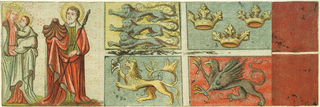
The gin pennant (sometimes gin flag or drinking pennant) is a maritime flag. When flown aboard ship, it indicates an open invitation to other ships' officers to come aboard for drinks.

The gin pennant (sometimes gin flag or drinking pennant) is a maritime flag. When flown aboard ship, it indicates an open invitation to other ships' officers to come aboard for drinks.
The gin pennant appeared at least as early as the 1940s, and possibly long before. Flying the gin pennant was an invitation (generally aimed at officers) to come aboard for a (free) drink in the ship's wardroom. (Consequently, junior officers would sometimes compete and conspire to fly the gin pennant aboard other ships.) Gin pennants likely originated in, and remain in use today, in the Commonwealth navies. [1] [2]
The gin pennant exists in several variants. Due to their rather informal nature, gin pennants may be improvised or customized from available flags and pennants. The simplest option is to fly the "starboard" manoeuvering signal pennant (a pennant with a white field, and green hoist and fly).
Purpose-made gin pennants often take the form of a starboard pennant defaced with a wine, cocktail, or martini glass (typically green, sometimes gray or black) on the field.
Another variant described is a small triangular flag in solid green, defaced with a white cocktail or wine glass.
Gin pennants have also been produced as novelties by distillers. In the 1950s, the makers of Gordon's Gin distributed Gordon's pennants in reversed colors: a green field with white hoist and fly, defaced with a gin bottle, glass, and the word GORDON'S. [3]

A flag is a piece of fabric with distinctive colours and design. It is used as a symbol, a signalling device, or for decoration. The term flag is also used to refer to the graphic design employed, and flags have evolved into a general tool for rudimentary signalling and identification, especially in environments where communication is challenging. Many flags fall into groups of similar designs called flag families. The study of flags is known as "vexillology" from the Latin vexillum, meaning "flag" or "banner".

A gin and tonic is a highball cocktail made with gin and tonic water poured over a large amount of ice. The ratio of gin to tonic varies according to taste, strength of the gin, other drink mixers being added, etc., with most recipes calling for a ratio between 1:1 and 1:3. It is usually garnished with a slice or wedge of lime. To preserve effervescence, the tonic can be poured down a bar spoon. The ice cools the gin, dulling the effect of the alcohol in the mouth and making the drink more pleasant and refreshing to taste.

The national flag of Romania is a tricolour. The Constitution of Romania states that "The flag of Romania is tricolour; the colours are arranged vertically in the following order from the flagpole: blue, yellow, red". The flag has a width-length ratio of 2:3; the proportions, shades of colour as well as the flag protocol were established by law in 1994, and extended in 2001. Its similarity to the flag of Chad has caused international discussion.
Flag terminology is the nomenclature, or system of terms, used in vexillology, the study of flags, to describe precisely the parts, patterns, and other attributes of flags and their display.

In British maritime law and custom, an ensign is the identifying flag flown to designate a British ship, either military or civilian. Such flags display the United Kingdom Union Flag in the canton, with either a red, white or blue field, dependent on whether the vessel is civilian, naval, or in a special category. These are known as the red, white, and blue ensigns respectively.

The martini is a cocktail made with gin and vermouth, and garnished with an olive and/or a lemon twist. Over the years, the martini has become one of the best-known mixed alcoholic beverages. A common variation, the vodka martini, uses vodka instead of gin for the cocktail's base spirit.

A maritime flag is a flag designated for use on ships, boats, and other watercraft. Naval flags are considered important at sea and the rules and regulations for the flying of flags are strictly enforced. The flag flown is related to the country of registration: so much so that the word "flag" is often used symbolically as a metonym for "country of registration".

The White Ensign, at one time called the St George's Ensign because of the simultaneous existence of a crossless version of the flag, is an ensign worn on British Royal Navy ships and shore establishments. It consists of a red St George's Cross on a white field, identical to the flag of England except with the Union Flag in the upper canton.

A jack is a flag flown from a short jackstaff at the bow (front) of a vessel, while the ensign is flown on the stern (rear). Jacks on bowsprits or foremasts appeared in the 17th century. A country may have different jacks for different purposes, especially when the naval jack is forbidden to other vessels. The United Kingdom has an official civil jack; the Netherlands has several unofficial ones. In some countries, ships of other government institutions may fly the naval jack, e.g. the ships of the United States Coast Guard and the National Oceanic and Atmospheric Administration in the case of the US jack. Certain organs of the UK's government have their own departmental jacks. Commercial or pleasure craft may fly the flag of an administrative division or municipality at the bow. Merchant ships may fly a house flag. Yachts may fly a club burgee or officer's flag or the owner's private signal at the bow. Practice may be regulated by law, custom, or personal judgment.

The commissioning pennant is a pennant flown from the masthead of a warship. The history of flying a commissioning pennant dates back to the days of chivalry with their trail pendants being flown from the mastheads of ships they commanded. Today, the commissioning pennants are hoisted on the day of commissioning and not struck until they are decommissioned. Some navies have a custom of flying a "paying off" or "decommissioning pennant," the length of which often reflects the length of service of the warship.

A pennon, also known as a pennant or pendant, is a long narrow flag which is larger at the hoist than at the fly, i.e., the flag narrows as it moves away from the flagpole. It can have several shapes, such as triangular, tapering or triangular swallowtail, etc. In maritime use, pennants are to be hung from the main truck.

A battle ensign is the name given to a large war ensign (flag) hoisted on a warship's mast just before going into battle.

A sour is a traditional family of mixed drinks. Sours belong to one of the old families of original cocktails and are described by Jerry Thomas in his 1862 book How to Mix Drinks.

The Australian white ensign is a naval ensign used by ships of the Royal Australian Navy (RAN) from 1967 onwards. From the formation of the RAN until 1967, Australian warships used the British white ensign as their ensign. However, this led to situations where Australian vessels were mistaken for British ships, and when Australia became involved in the Vietnam War, the RAN was effectively fighting under the flag of another, uninvolved nation. Proposals were made in 1965 for a unique Australian ensign, which was approved in 1966, and entered use in 1967.

A French ensign is the flag flown at sea to identify a vessel as French. Several such ensigns have existed over the years as well as terrestrial flags based on the ensign motif.

A broad pennant is a triangular swallow-tailed naval pennant flown from the masthead of a warship afloat or a naval headquarters ashore to indicate the presence of either:

The ensign of the United States is the flag of the United States when worn as an ensign. International maritime law—see International Treaty on Law of the Sea, articles 91 and 92—provides that vessels have a "national character" and thus should display a flag (ensign) that corresponds to this national character, especially when in international or foreign waters. Vessels that are formally documented under the federal vessel documentation act, vessels owned by government bodies in the United States, and vessels in the U.S. military unquestionably have U.S. national character, and thus properly hoist a U.S. ensign to show their national character. Vessels that are numbered by the states and small, non-registered craft owned by U.S. citizens and not registered in other countries may also hoist a U.S. ensign to show their national character.

A "fizz" is a mixed drink variation on the older sours family of cocktail. Its defining features are an acidic juice and carbonated water. It typically includes gin or rum as its alcoholic ingredient.

The Star of India refers to a group of flags used during the period of the British Raj in the Indian subcontinent. India had a range of flags for different purposes during its existence. The Princely states had their own flags which were to be flown alongside the British flag as a symbol of suzerainty. The official state flag for use on land was the Union Flag of the United Kingdom and it was this flag that was lowered on Independence Day in 1947. The flag of the governor-general of India was defaced with the Star of India. The civil ensign and naval ensign were the Red Ensign or Blue Ensign, respectively, defaced with the Star of India emblem.

New England has no official flag. However, there have been many historical or modern banners used to represent the region in its history. While there are some variations, common designs include a plain colored field with a pine tree in the canton. The eastern white pine is the most common and prominent symbol of New England and is featured on many of the region's flags.